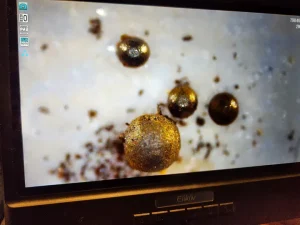
A scientific expedition led by Galileo Project scholars Avi Loeb and Amir Siraj have recovered what may be the first material known to have originated from beyond the solar system, in the form of tiny pearl-like spherules comprised of a peculiar mix of metals that were recovered from the impact point of an interstellar meteor that struck the Earth in 2014. Although the interstellar meteor was likely a naturally-formed object, a number of the object’s properties have led Loeb to speculate that, much like 2017’s ʻOumuamua, these re-formed blobs of metal may be the product of an extraterrestrial civilization.
On April 13, 2022, a memo from U.S. Space Command was released confirming that a meteor designated CNEOS 2014-01-08 was travelling at roughly 60 kilometers per second (37.3 miles per second) when it impacted the Earth on January 8, 2014—a speed far too fast to be an object bound by the gravity of the Sun, meaning it had to have originated from interstellar space.
This confirmed the calculations regarding CNEOS 2014-01-08’s trajectory that were published by Harvard astrophysicist Amir Siraj, who, along with paper co-author Loeb, calculated that the half-meter (1.5-foot) object’s speed was three times greater than that of something that would be able to stay in orbit around the Sun.
Because CNEOS 2014-01-08, now being called interstellar meteor 1, or IM1, was tracked during its entry into the atmosphere, the area where it should have impacted was easily determined: a spot in the Indian Ocean just northeast of Papua New Guinea. Knowing the area where a potential interstellar object might be found prompted Loeb and Siraj to launch an expedition to recover any debris that may have survived the object’s high-speed impact with the atmosphere.
“One thing that I’m going to be checking—and I’m already talking to people about—is whether it is possible to search the ocean floor off the coast of Papua New Guinea and see if we can get any fragments,” Siraj said in an interview with Vice Magazine in April 2022. That expedition was launched on June 14, 2023, and employed a magnetic sled that was drawn along the ocean floor behind the aluminum-hulled research vessel, Silver Star, to collect potential artifacts from IM1 that may have settled on the seabed.
On June 21, their efforts bore fruit in the form of a metal spherule, “0.3 millimeter in size, looking like a metallic pearl on the background of volcanic ash,” that had been snagged by the sled’s magnets, according to Loeb’s journal entry; melting under the intense heat generated from entering the atmosphere, the metals that make up meteors typically re-solidify into easily-identifiable spheres. The collection sled eventually collected fifty similar spherules, totaling 35 milligrams of the magnetic orbs; a control collection conducted outside of IM1’s projected path yielded no metal spherules, indicating that these artifacts did indeed originate from the interstellar meteor.
An initial analysis of the first sample found that the spherule was made up of 84 percent iron, eight percent silicon, five percent magnesium, two percent titanium, with the remaining one percent being made up of trace elements. Curiously, the sample contained no nickel; the majority of recovered iron meteorites contain between five and 25 percent nickel, so the element’s absence is notable. Through the ratios of the uranium and lead isotopes present in two of the samples, the age of IM1 appears to be on the order of that of the visible universe—nearly 14 billion years old, making it much older than the 4.8 billion years since the formation of the Solar System.
The samples have arrived at the University of California at Berkeley for their first round of testing; although their analysis will offer valuable insight into the nature of objects from beyond the farthest reaches of the Solar System, Loeb is curious as to whether or not IM1 was an artificially-constructed object, originating from an extraterrestrial civilization.
“The fundamental question is obvious: was this first recognized interstellar object from 2014 manufactured by a technological civilization?” Loeb mused in his June 21 journal entry. “Upon our return, we could produce an alloy in the laboratory that has the same composition as we infer for the spherules and analyze the resulting material properties.”
Additionally, based on IM1’s speed when the object broke up in the atmosphere, its tensile strength appears to have been more than twice as high as the next-toughest known meteorite, one that broke up in the atmosphere in March 2017. Loeb also wonders if IM1’s remarkable speed—not only nearly two and a quarter times faster than ʻOumuamua’s Sun-dodging velocity, but also faster than 95 percent of the stars in our local neighborhood—might be the product of artificial propulsion having been applied to the object at some point in its history.
Subscribers, to watch the subscriber version of the video, first log in then click on Dreamland Subscriber-Only Video Podcast link.
Why the UAP tie in? Most likley rare space minerals?
The UAP talk might be part of a larger agenda by Avi Loeb to accustom his fellow scientists to the idea that there may be extraterrestrial civilizations around, but he’s doing this in a slow and cautious way…
I think because the article talks about evidence of speed possibly caused by artificially created propulsion.